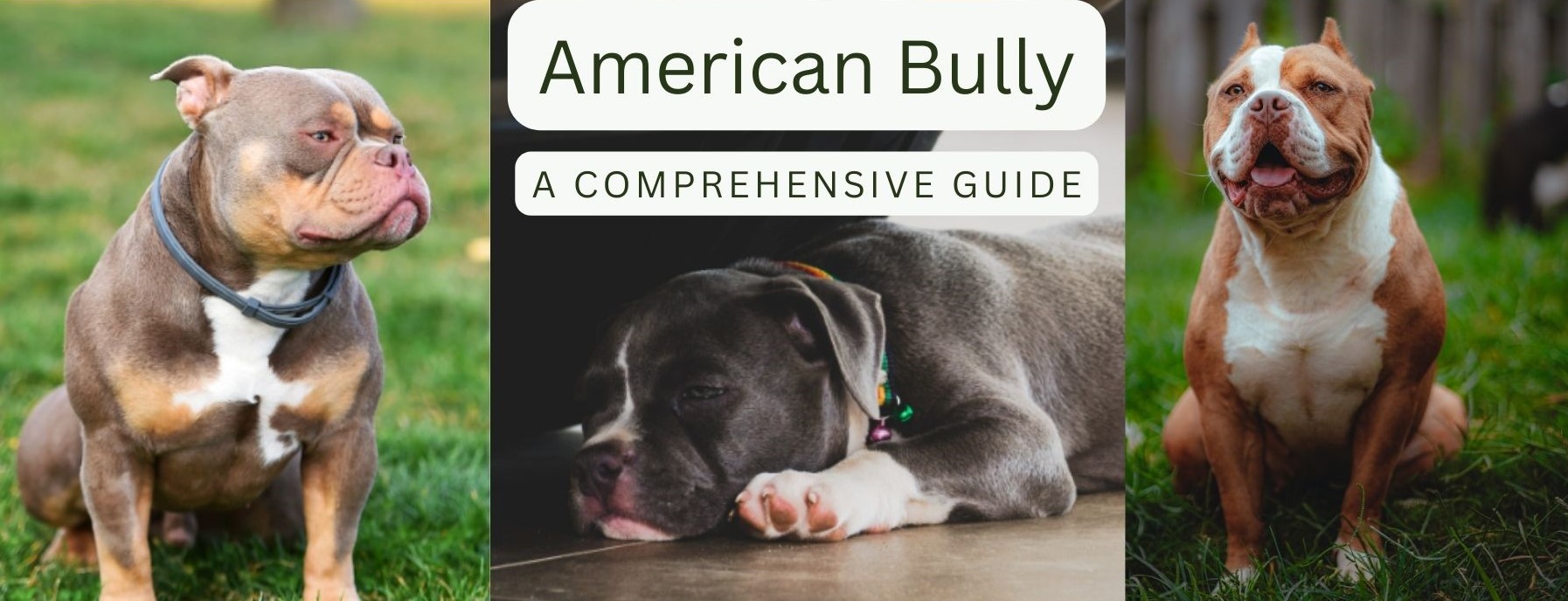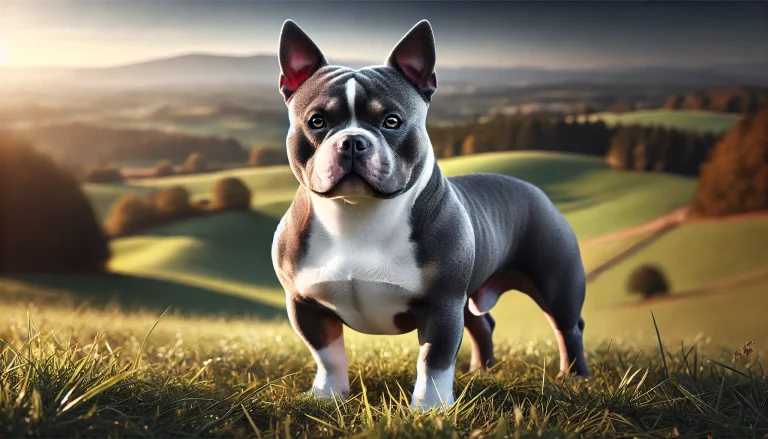American Bully The Giant and Gentle Partners
If you’re drawn to dogs with muscular builds, big blocky heads, and hearts bursting with love, then the American Bully might just be your perfect match. These powerful pups combine unwavering loyalty with a goofy, playful streak that’s sure to win you over. But there’s a lot more to these gentle giants than their impressive appearance.
History of the American Bully breed:
A Recent Creation with Deep Roots
The American Bully is a relatively new dog breed, yet its origin story tells of dedication, selective breeding, and the desire to create the ultimate companion dog. Here’s a breakdown of its rich history:
The Origins: A Blend of Bulldogs and Terriers
The foundation of the American Bully lies in its ancestors – namely, the American Pit Bull Terrier (APBT) and the American Staffordshire Terrier. Breeders aimed to retain the APBT’s friendly, people-oriented nature and the American Staffordshire Terrier’s devoted companionship while selectively breeding to lessen prey drive and minimize any dog-aggression tendencies.
The 1980s & 1990s: The Start of a New Breed
In the United States, dedicated breeders began their vision of the American Bully. During this time, breeders experimented with careful bloodline selections, adding contributions from other bulldog-type breeds like the English Bulldog and the French Bulldog. These additions further emphasized the desired physical traits – broad heads, muscular builds, and a sweet, affectionate nature.
The Rise of the American Bully Kennel Club (ABKC)
In 2004, the American Bully Kennel Club (ABKC) was founded, establishing breed standards and providing registry for these stunning dogs. Their recognition fueled popularity and led to a more streamlined focus on developing the ideal American Bully temperament and appearance.
Evolution and Variations
As the breed gained recognition, different varieties emerged within the American Bully classification. While all Bullies possess those core breed traits, there’s some diversity:
- Pocket Bully: The compact member of the American Bully family.
- Standard Bully: Possesses the quintessential classic Bully look.
- XL Bully: The largest of the Bullies, turning heads with their size and impressive muscle.
- Extreme Bully: This type displays exaggerated features, maximizing muscle mass and width.
The Growing Popularity of the American Bully
Despite controversies, the American Bully’s loyal following continues to grow. Drawn to their gentle nature, striking looks, and unwavering affection, more and more families are recognizing the true heart of this captivating breed.
Types of American Bullies
The American Bully breed encompasses several variations, primarily differing in size:
Pocket Bully: The Compact Powerhouse
Smaller than the standard American Bully, Pocket Bullies pack a lot of muscle into their compact frames. They stand shorter but carry that signature Bully muscle definition.
Standard Bully: The Classic American Bully Look
Standard American Bullies represent the most common type. They possess the hallmark traits of the breed: powerful build, wide chest, and broad head.
XL Bully: An Imposing and Impressive Figure
XL Bullies are the largest type in the American Bully family. Their size alone draws attention, but they’re just as loving and playful as their smaller counterparts.
Extreme Bully and Other Variations: Understanding the Differences
The Extreme Bully type often displays exaggerated features, with an even stockier build and more muscle mass. Additionally, several less common variations within the breed exist.
American Bully Coats and Colors: A Spectrum of Choices
Common American Bully Colors
American Bullies sport a beautiful variety of coat colors and patterns. Some of the most common include:
Solids: Black, blue, fawn, chocolate, tan, red,
Brindle: Classic stripes of varying colors
Piebald: Large patches of color on a white background
Merle vs. Tri-Color: What’s the Difference?
These often get confused! Here’s how to tell them apart:
Merle: A beautiful “marbled” effect where spots of darker color appear over a lighter base. Be aware that merle colors can sometimes be associated with specific health concerns.
Tri-Color: Three distinct colors are present – usually black, tan, and white, or various shades of brown, tan, and white.
Rare and Exotic: Show-Stopping Shades
Some truly unique colors emerge in the American Bully breed:
Lilac: A diluted chocolate shade with an almost bluish or silvery hue.
Champagne: A lighter fawn-like color with striking appeal.
Myths and Truths about American Bullies
“They’re Aggressive by Nature”: Setting the Record Straight
This is the biggest misconception about American Bullies! Like any dog, poor socialization or irresponsible ownership can lead to behavioral problems. However, well-bred American Bullies are typically gentle, loving, and eager to please.
Responsible Ownership: The Key to Preventing Problems
With any dog breed, especially powerful ones, responsible ownership is crucial. This includes:
Thorough training and socialization from a young age
Consistent leadership and setting boundaries
Providing sufficient exercise and mental stimulation
The American Bully Temperament – The Misunderstood Sweetheart
While their appearance might seem intimidating, American Bullies are known for their incredibly loving and affectionate personalities. Here’s a look at their temperament:
Family Devotion: American Bullies adore their people! They crave attention and love being involved in family activities.
Gentle Giants: Don’t let their tough looks fool you – these dogs are sweethearts, especially with children. Their patience and playfulness make them wonderful family companions.
Playful and Energetic: Get ready for some fun! American Bullies love to play, whether it’s fetch, tug-of-war, or just a good old-fashioned zoomie session around the yard.
The American Bully Community: Events, Shows, and Resources
Finding Your Pack: Connect with Other Bully Owners
Whether online or in your local area, the American Bully community is passionate and welcoming. Connecting with other Bully owners is a great way to get support, learn, and share your love for this amazing breed.
American Bully Shows: A Celebration of the Breed
If you’re fascinated by the beauty and diversity of American Bullies, shows offer a great opportunity to admire the breed and meet dedicated breeders and owners. These events are full of energy and a fantastic way to witness the athleticism and structure of these dogs.
Breed-Specific Rescue Organizations: Giving Second Chances
Sadly, some American Bullies end up in shelters due to no fault of their own. Thankfully, dedicated rescue organizations focus on finding forever homes for these dogs. If you’re considering adopting, please research breed-specific rescues in your area.
Is an American Bully the Right Dog for Me?
Before falling head over heels for those expressive eyes, ask these important questions:
Ideal Living Environments: Apartment-Friendly or Needing Space?
While American Bullies can adapt to smaller living spaces, they thrive with room to play. A house with a backyard for playtime is ideal.
Family Companions: Good with Kids and Other Pets?
Absolutely! With proper socialization and training, American Bullies make fantastic family dogs. Their inherent patience and gentleness make them great with children. Early introductions are key if you have other pets. Bringing Your American Bully Home: Puppy Essentials
American Bully Puppies 101: Finding Responsible Breeders
Choosing a reputable and ethical breeder is crucial for the health and temperament of your American Bully pup. Do your research! Look for breeders who prioritize health testing and the well-being of their dogs.
Choosing the Right Puppy: Matching Temperament to Your Lifestyle
Each puppy has its own personality. When selecting your Bully, observe their interaction with littermates and humans. Are they playful? Shy? A good breeder will help you find the perfect pup to suit your lifestyle.
Essential Supplies Checklist: Beyond the Food Bowl
Stock up before your pup arrives! Your checklist should include:
- High-quality food suitable for their breed and age
- Sturdy bowls for food and water
- Leash, collar or harness
- Comfy bed or crate
- Plenty of toys to keep them entertained
Training Your American Bully: Building a Strong Bond
The Importance of Early Socialization
The foundation for a well-behaved American Bully starts with early socialization. Safely expose your pup to different people, places, and situations when they’re young. This builds confidence and makes them comfortable in the world.
Obedience Training: The Foundation for Happy Coexistence
Teaching your Bully basic obedience commands like “sit,” “stay,” “down,” and “come” isn’t just about showing off tricks. It builds communication, creates structure, and keeps them safe. Positive reinforcement training methods work wonders with this breed!
Harnessing their Power: Leash Manners and Strength Training
American Bullies are strong! Teaching loose-leash walking takes patience and consistency. Strength-building exercises, like weight pulling (under careful supervision), can provide a healthy outlet for their energy and enhance muscle development.
Exercise Needs: How Much Playtime Do These Powerhouses Need?
American Bullies have moderate exercise needs. Expect to provide daily walks, engaging play sessions, and perhaps even strength-building activities to keep them in peak condition.
Keeping Your American Bully Healthy and Happy
Veterinary Care: Wellness Visits and Breed-Specific Considerations
Regular veterinary checkups are essential for all dogs. Be aware of some health concerns American Bullies may be prone to, like hip dysplasia or skin allergies. Your vet can guide you on how to best prevent and manage these.
Common Health Concerns: What to Watch Out For
Responsible breeders work to minimize health issues, but be aware of these potential problems in American Bullies:
- Hip and elbow dysplasia: Joint problems in larger breeds
- Allergies: Sensitive skin or food allergies
- Eye problems: Issues like cherry eye can occur
Diet and Nutrition: Feeding Your Muscle Machine
A high-quality diet tailored to your American Bully’s age, size, and activity level is vital. Avoid overfeeding to prevent unhealthy weight gain, which can put a strain on their joints. Consult your veterinarian for guidance and recommendations.
Grooming Your American Bully: Beyond the Basics
Coat Care: Shine On!
American Bully’s short coat is easy to maintain. Weekly brushing keeps it shiny and reduces shedding. Regular baths keep them looking and smelling fresh.
Maintaining Ear and Skin Health
Help prevent ear infections with regular cleaning, especially in dogs with floppy ears. American Bullies can have sensitive skin, so watch for any patches of irritation and address those with your vet.
Nail Trimming Tips: Tame Those Talons!
Familiarize your Bully with nail trims early on. If you’re uncomfortable doing it yourself, a groomer or vet tech can help. Overgrown nails can be painful and affect their gait.
Are American Bullies good for first-time dog owners?
It depends. American Bullies are loving and playful, but they’re strong and can be stubborn. They need consistent training and lots of socialization. It’s a big commitment.
American Bullies might not be ideal if you’ve never owned a dog before. They need strong leadership and lots of time to learn how to be awesome companions.
How much does an American Bully cost?
Okay, let’s be honest, American Bullies aren’t cheap. But understanding what affects the price helps you make the right choice for your budget and get the most amazing dog possible!
Factors that Influence Price
Breeder Reputation: Responsible breeders prioritize health testing, good temperament, and ethical practices. This costs more upfront but saves you heartache (and vet bills!) in the long run.
Bloodlines & Show Prospects: Pups from champion lines or with the potential to compete in shows cost significantly more.
Type of Bully: Expect to pay more for those in-demand XLs or rare Pocket Bullies.
Color & Markings: Unique colors like lilac, champagne, or tri-colors can drive up the price tag.
Average Price Ranges
Pet-Quality Bully: $2,500 – $7,000 is a reasonable ballpark.
Show/Breeding Prospects: Plan on $5,000 – $15,000 or even higher for top-tier puppies.
Veterinary Care: Routine checkups, vaccinations, and preventative meds – it adds up!
Quality Food: These powerful pups need a diet that supports their build.
Supplies: Crate, leash, toys, grooming tools – budget for these essentials.
Training: Obedience classes or even specialized training for sports is worth the investment
Bottom Line
Finding the Right Breeder: Ask about health testing, meet the parents, and see the pups’ environment. A good breeder is worth the higher initial cost.
Consider Adoption: Amazing Bullies end up in shelters! You could find your perfect match, give a dog a second chance, AND save money.
Can American Bullies be left alone for long periods?
Honestly, not really. These dogs are like your biggest, most lovable buddies and they don’t want to hang out at home alone all day.
Here’s why:
Velcro dogs: Think of them as big shadows that always want to be near you. Leave them solo for too long, and they get stressed out and might start acting out.
Energy to burn: All that Bully muscle isn’t just for show! They need walks, playtime, and some brain-teaser toys to keep them happy. Not doing that makes for a bored pup, and trust me, a bored Bully gets creative (couch cushions won’t survive).
They’re big softies: American Bullies may look tough, but deep down, they’re cuddle bugs. They want to be with their favorite people!
My advice:
If you’re gone for long hours during the day, consider a different breed that loves alone time a bit more. American Bullies thrive when they’re with their family. You miss out on the best parts of this breed if they’re constantly waiting for you to come home!
Frequently Asked Questions (FAQs)
Insurance and Legal Issues: Are there Breed-Specific Regulations?
In some areas, Breed Specific Legislation (BSL) or insurance restrictions may affect American Bully ownership. Always check local laws and speak with your insurance provider before bringing home a Bully.
Beyond the Basics: Advanced Training, Agility, and More
American Bullies are intelligent and athletic dogs. If you’re looking for challenging activities, consider advanced training like protection work (only with responsible organizations), agility, or scent work.
Conclusion
American Bullies are extraordinary dogs with so much to offer. From their loving personalities to their playful antics, they make incredible companions. Remember, responsible ownership, training, and commitment are key to creating a happy and fulfilling life with an American Bully.
If you’re intrigued by these unique dogs, take the time to learn more, visit an American Bully show, or connect with the passionate community of Bully enthusiasts. You might just fall in love with the breed!



